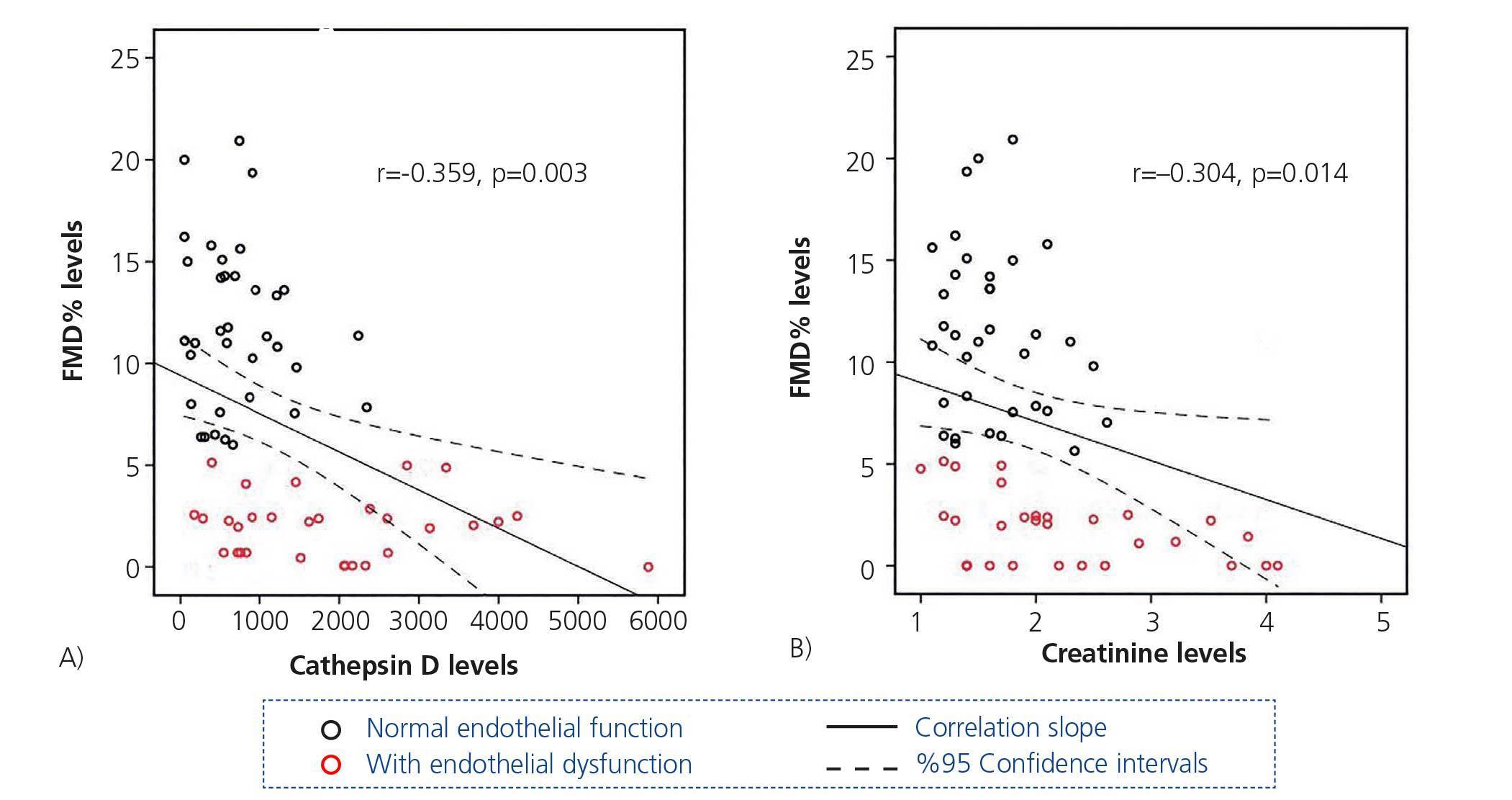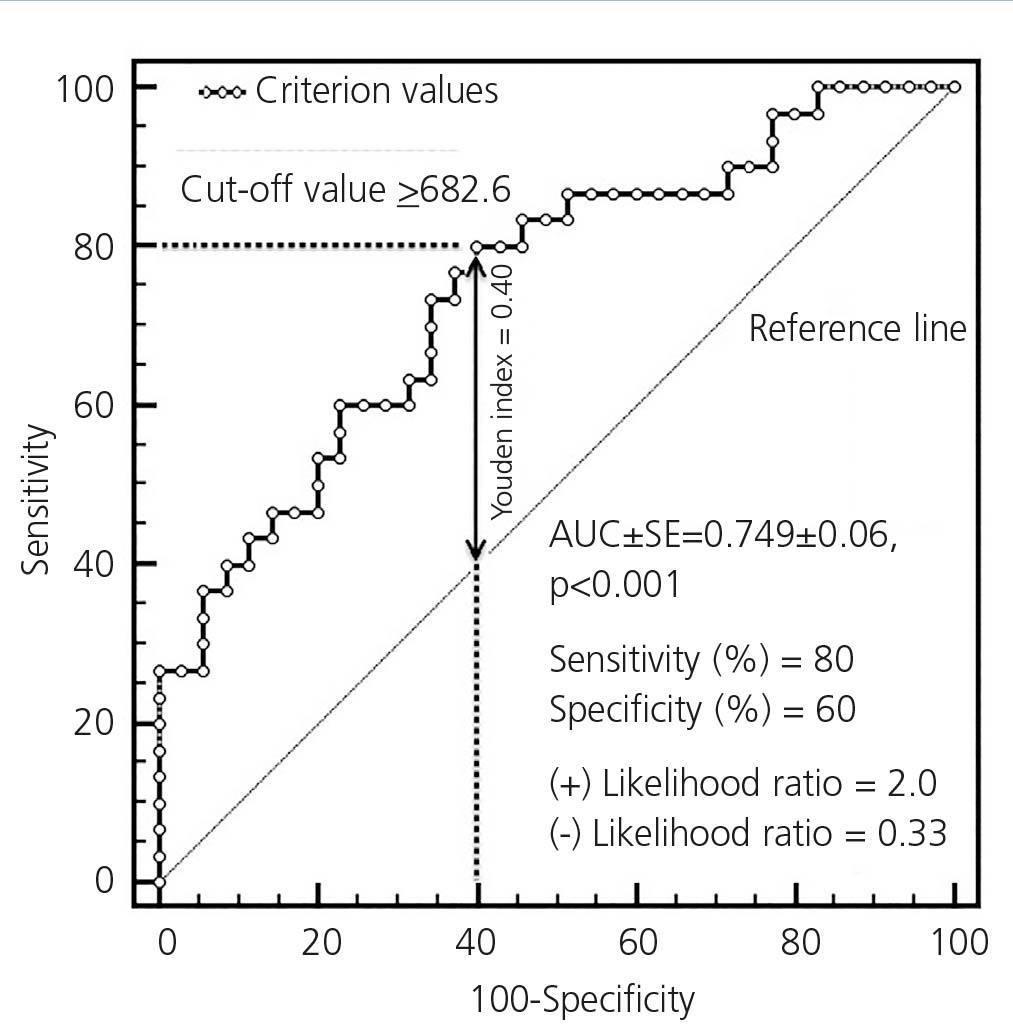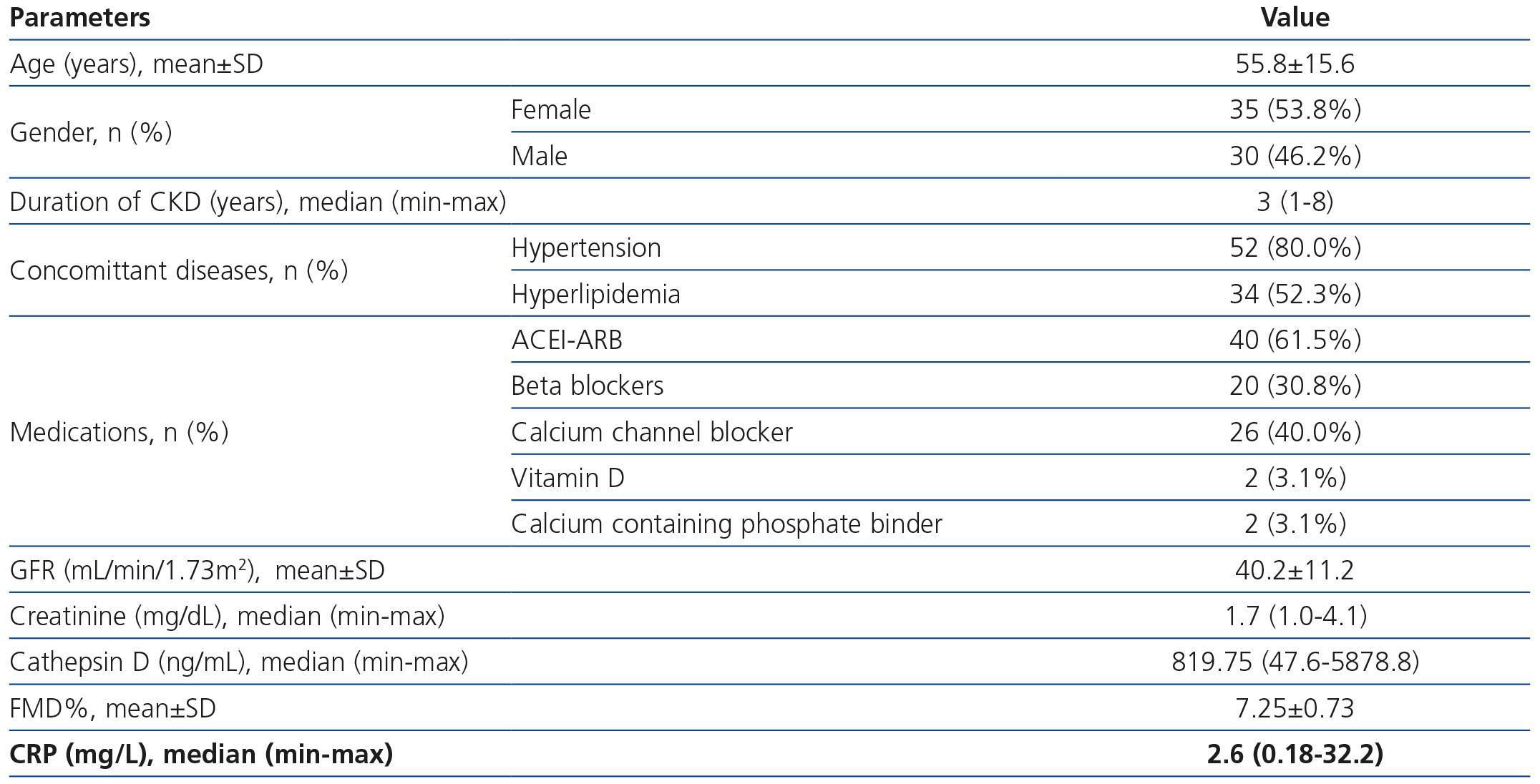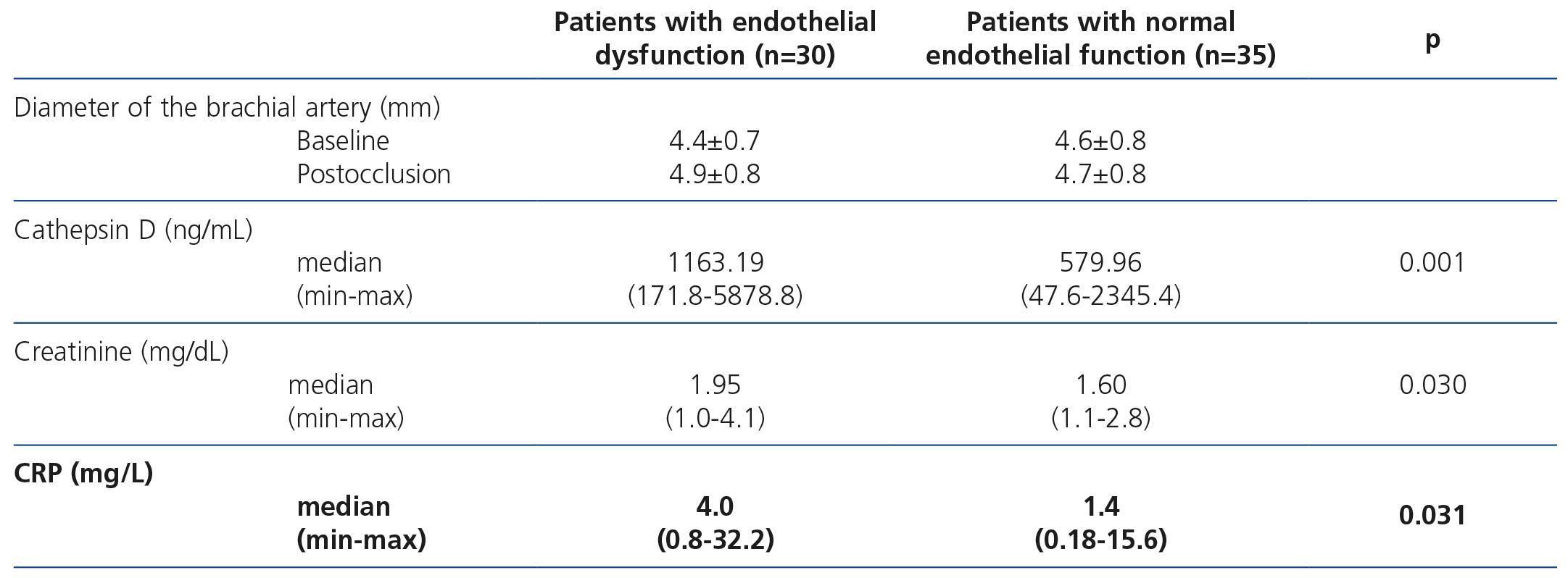We aimed to investigate the role of cathepsin D, an inflammatory and atherosclerotic mediator, in endothelial dysfunction in chronic kidney disease. The study included 65 patients with stage 2–4 chronic kidney disease (35 females, 30 males; mean age, 55.8±15.6 years). Serum creatinine and cathepsin D levels and glomerular filtration rates (GFRs) were determined, and brachial flow-mediated dilation (FMD) percentage was measured by two-dimensional gray scale and color flow Doppler and vascular imaging. FMD ≤6% was considered to indicate endothelial dysfunction. Mean GFR, median creatinine levels, and median cathepsin D levels were 40.2±11.2mL/min/1.73m2, 1.7mg/dL, and 819.75ng/mL, respectively. Endothelial dysfunction was present in 30 of the 65 patients (46.2%). There was a significant difference between groups with and without endothelial dysfunction in terms of cathepsin D (p=0.001) and creatinine (p=0.03) levels, and negative and significant correlations were found between brachial artery FMD% and cathepsin D (r=−0.359, p=0.003) and creatinine (r=−0.304, p=0.014) levels. Cathepsin D, which is known to be associated with atherosclerosis, may play a role in the process of endothelial dysfunction. Further studies are essential to determine the exact function of cathepsin D in endothelial dysfunction in chronic kidney disease and to determine its value as a tool for early diagnosis and target for treatment of cardiovascular diseases in patients with chronic kidney disease.
Este estudio se llevó a cabo con el objetivo de investigar el papel de la catepsina D, un mediador inflamatorio y aterosclerótico de la disfunción endotelial en la enfermedad renal crónica. En él, se incluyó a 65 pacientes con enfermedad renal crónica en los estadios 2-4 (35 mujeres y 30 hombres con una media de edad de 55,8 ± 15,6 años). Se calcularon los niveles séricos de creatinina y catepsina D así como la tasa de filtrado glomerular (TFG) y se midió el porcentaje de dilatación mediada por flujo (DMF) de la arteria braquial mediante angiografía y ecografía doppler bidimensional en color y en escala de grises. Se consideró que una DMF de ≤6% era indicativa de disfunción endotelial. La TFG media, la mediana de los niveles de creatinina y la mediana de los niveles de catepsina D fueron, respectivamente, 40,2 ± 11,2 mL/min/1,73 m2; 1,7 mg/dL; y 819,75 ng/mL. La disfunción endotelial afectaba a 30 de los 65 pacientes (46,2%). Entre los grupos con y sin disfunción endotelial, se observó una diferencia significativa en los niveles de catepsina D (p = 0,001) y creatinina (p = 0,03) así como correlaciones significativas y negativas entre el porcentaje de DMF de la arteria braquial y los niveles de catepsina D (r = −0,359, p = 0,003) y creatinina (r = −0,304, p = 0,014). La catepsina D, que se asocia a la aterosclerosis, tiene un papel importante en el proceso de disfunción endotelial. Es fundamental que se realicen otros estudios que puedan determinar la función exacta de la catepsina D en la disfunción endotelial y su valor como herramienta de diagnóstico temprano y como diana del tratamiento de enfermedades cardiovasculares en pacientes con enfermedad renal crónica.
INTRODUCTION
Cardiovascular diseases, including coronary artery disease, are the leading cause of mortality and morbidity in chronic renal disease.1,2 Increased risk of cardiovascular diseases results from accelerated development of atherosclerosis in patients with chronic renal disease. Atherosclerosis in chronic renal disease is related to risk factors associated with uremia, such as anemia, hyperhomocysteinemia, abnormal calcium and phosphate metabolism, increase in asymmetric dimethylarginine levels, oxidative stress, and inflammation, in addition to the traditional risk factors such as hypertension, hyperlipidemia, and diabetes mellitus.2-5
Atherosclerosis is associated with endothelial dysfunction. Inflammation is one of the important causes of endothelial dysfunction, which leads to atherosclerosis. Vascular endothelium releases both vasodilator (such as nitric oxide, endothelium-derived relaxing factors, and prostacyclin) and vasoconstrictor (such as thromboxane A2, free radicals, and endothelin) substances and plays a fundamental role in the prevention of atherosclerosis, with local regulation of vascular tonus. In endothelial dysfunction, the vasodilation ability of the endothelium decreases.6,7
Endothelial dysfunction is an early sign of subclinical atherosclerosis and plays an important part in the pathogenesis of cardiovascular diseases.6 Recent studies demonstrated that endothelial dysfunction revealed by non-invasive methods can be used as a prognostic marker for cardiovascular diseases.8,9 The presence of endothelial dysfunction was shown in chronic renal disease at predialysis, dialysis, and renal transplantation stages.10-12 Cathepsin D is a protease soluble lysosomal aspartic endopeptidase that contributes to intracellular protein degradation. Cathepsin D normally brings about the degradation of proteins in acidic pH in lysosomes and formation of mature active peptides in endosome.13 Although cathepsin D plays an important role in various biological and inflammatory events, its inflammatory characteristics remain to be fully explained. Various studies have suggested that cathepsin D may be a potential marker of atherosclerosis.14-18 However, studies on the potential role of cathepsin D in endothelial dysfunction of chronic kidney disease are limited.18 Better understanding of the mechanisms and risk factors contributing to endothelial dysfunction may lead to novel therapeutic strategies to decrease cardiovascular disease risk and to manage endothelial dysfunction in patients with chronic kidney disease.
The aim of the present study was to investigate the role of cathepsin D, an inflammatory and atherosclerotic mediator, in endothelial dysfunction of chronic kidney disease, which was assessed by the flow-mediated dilation (FMD) test.
MATERIAL AND METHOD
Subjects
This was a prospective, single-arm study. Patients with stage 2-4 chronic renal disease were included in the study between May 2013 and August 2013. Those with diabetes mellitus, coronary heart disease, heart failure, peripheral artery disease, cerebrovascular event, malignancy, acute or chronic infection, and smoking history were excluded.
The study was conducted in accordance with the Declaration of Helsinki and was approved by the Local Ethics Research Committee. All subjects provided written informed consent prior to participation in the study.
Laboratory procedures
Blood sampling was performed between 8 and 9 a.m. after an overnight fast. Laboratory values included complete blood count, kidney function tests, calcium levels, fasting plasma glucose levels, and lipid profile.
The glomerular filtration rate (GFR) was calculated using the Chronic Kidney Disease Epidemiology Collaboration (CKD-EPI) equation: GFR=141 ´ min(Scr/κ,1)α ´ max(Scr/κ,1)−1.209 ´ 0.993Age ´ 1.018[if female] ´ 1.159[if black].19
For the measurement of cathepsin D levels, blood samples drawn from patients were centrifuged for 15min at 3000rpm, and the serum fraction was separated and stored at −80°C until analysis. Serum levels of soluble cathepsin D were measured with an enzyme-linked immunosorbent assay (ELISA) kit (QIA29 Cathepsin D, Rapid Format ELISA Kit, Calbiochem, USA). Each assay was calibrated using a cathepsin D standard curve following the manufacturer’s instructions.
Brachial flow-mediated vasodilatation
All patients underwent brachial FMD testing after a 12-h fast. The patients were instructed not to consume caffeine-rich beverages for 12h and not to take any cardiac medication for 24h prior to measurements. Measurements of FMD using brachial artery reactivity were performed by two-dimensional gray scale and color flow Doppler and vascular imaging using a Logiq Book XP ultrasonography device (General Electric Healthcare, Milwaukee, Wisconsin, USA) with a 10-MHz vascular ultrasound probe in a quiet room at 22°C.
After 5min of rest in a supine position, the arm was prepared for measurements (3 patients had an arteriovenous fistula on the left arm incised by other centers that followed up the patients. FMD measurements of these patients were performed on the arm with no fistula). The brachial artery was scanned longitudinally at 2-5cm under the antecubital crease. This location was marked on the skin, and all subsequent measurements were performed at the same location. The arm was splinted with a prosthetic splint and secured with straps above and below the elbow.
The mean diameter of the brachial artery was determined at baseline. Then, 5min of arterial occlusion was achieved by inflating the occlusion cuff of a sphygmomanometer placed on the upper arm to 50mmHg above the systolic blood pressure. Post-occlusion measurements were made 1min after cuff deflation. Two images were averaged to determine the brachial artery diameter. To calculate FMD, percent diameter changes were determined as follows: (diameter after arterial occlusion − baseline diameter)/baseline diameter ´ 100.
All measurements were taken at the end of the diastole, at the same time as the R wave on a continuously recorded electrocardiogram.
Normal flow-mediated vasodilation in young, healthy subject series is approximately 6% using the lower-arm technique.7Normal endothelial functions were defined as FMD >6%; thus, FMD ≤6% was considered to indicate “endothelial dysfunction”.7 The same experienced operator, who was blinded to the clinical data of the patients, performed all brachial artery measurements.
Statistical analysis
Statistical evaluation was performed using Statistical Package for Social Sciences (SPSS) for Windows 20 (IBM SPSS Inc., Chicago, Illinois, USA) program. The Kolmogorov–Smirnov test was used to evaluate if the data were distributed normally. Among the numerical variables, those that were normally distributed were expressed as mean ± standard deviation and those that were not normally distributed were expressed as median. For normally distributed parameters, the independent sample t test was used, whereas for parameters that were not normally distributed, the Mann-Whitney U test was used. The relation between the parameters was analyzed using Spearman correlation analysis. For the determination of factors increasing the rate of brachial FMD, multivariate Robust regression analysis was used. Multiple logistic regression analysis was used to define independent predictors of endothelial dysfunction. The variables that were found to be significant in univariate analysis (p<0.05) were included in multiple regression analysis. Receiver operating characteristic (ROC) curves were plotted to determine the optimal cutoff values for cathepsin D in order to predict endothelial dysfunction and to establish the optimal cutoff points for use in clinical decision making. The true positive rate (sensitivity) and the false-positive rate (100-specificity) were plotted for each measurement and the area under the curve (AUC) was determined. Cutoff values were determined from the Youden index. Two-tailed p values <0.05 were considered significant.
RESULTS
Patient characteristics
In total, 65 patients with chronic kidney disease (35 females and 30 males) who met the inclusion criteria were enrolled. The mean age of the patients was 55.8±15.6 years, and median time after the diagnosis of chronic kidney disease was 3.0 years. Hypertension and hyperlipidemia were present in 52 (80.0%) and 34 (52.3%) patients, respectively. Of the 65 patients, 61.5% were on angiotensin-converting enzyme inhibitors-angiotensin receptor blockers (ACEI–ARB), 30.8% on beta blockers, and 40.0% on calcium channel blockers. No patient used erythropoietin. The demographic and clinical characteristics of the study patients are given in Table 1.
Laboratory findings
Mean GFR, median creatinine levels, mean FMD (%), and median cathepsin D levels were 40.2±11.2mL/min/1.73m2, 1.7mg/dL, 7.25±0.73, and 819.75ng/mL, respectively (Table 1).
Endothelial dysfunction
Endothelial dysfunction was present in 30 of the 65 patients (46.2%). The diameters of the brachial artery in patients with and without endothelial dysfunction are presented in Table 2. The baseline and post-occlusion diameters of the brachial artery were 4.6±0.8mm and 4.7±0.8mm, respectively, in patients with endothelial dysfunction and 4.4±0.7mm and 4.9±0.8mm, respectively, in those with normal endothelial function.
The group of patients with endothelial dysfunction and that without endothelial dysfunction showed no significant difference in terms of age, gender, hypertension, hyperlipidemia, duration of chronic kidney disease, antihypertensive classes, and use of vitamin D and calcium-containing phosphate binder (p>0.05). The demographic and clinical characteristics of the patients with and without endothelial dysfunction are presented in Table 3.
Cathepsin D levels vs. endothelial dysfunction
There was a significant difference between the groups with and without endothelial dysfunction in terms of median cathepsin D (p=0.001) and creatinine (p=0.030) levels and C-reactive protein (CRP) (p=0.031) levels (Table 2). In addition, negative and significant correlations were found between brachial artery FMD percentage and cathepsin D (r=−0.359, p=0.003) (Figure 1) and creatinine (r=−0.304, p=0.014) levels and CRP (r=-0.295, p=0.020). Also, positive significant correlations were found between CRP levels and cathepsin D (r=0.360, p=0.003) and negative significant correlations were found between CRP levels and GFR (r=-0.273, p=0.028) levels, and creatinine (r=-0.248, p=0.026). Also, not significant correlation were found between cathepsin D and GFR (r=-0.097, p=0.443), and creatinine (r=0.126, p=0.170).
Stepwise multiple robust regression analyses were performed to evaluate the predictors of FMD percentage levels. In regression analysis, cathepsin D was found to be an inverse predictor of FMD percentage (B+SE=-2.338±0.840, p=0.023). Among the risk factors influencing FMD percentage, it was established that a one-unit change in creatinine led to a 2.338-fold decrease in FMD percentage. Similarly, stepwise multiple logistic regression analyses were performed to evaluate predictors of endothelial dysfunction. In regression analysis, cathepsin D was found to be an inverse predictor of endothelial dysfunction (odds ratio = 1.100; 95% confidence interval = 1.045–1.218, p=0.010) (Table 4). It was determined that cathepsin D>682.6 predicted the decrease in FMD with a sensitivity of 80% and specify of 60% (AUC±SE=0.749±0.06, p<0.001) (Figure 2).
DISCUSSION
In the present study, we evaluated the relation between serum cathepsin D levels and endothelial dysfunction in patients with chronic kidney disease. We showed that serum cathepsin D levels were significantly higher in patients with endothelial dysfunction than in those with normal endothelial function, suggesting a potential role of cathepsin D in the process of endothelial dysfunction.
Atherosclerosis plays a key role in the pathogenesis of cardiovascular diseases, which is a common threat to patients with chronic kidney disease.20-22 In addition to the traditional risk factors for cardiovascular diseases, risk factors related to renal dysfunction that are much more common in patients with chronic kidney disease increase the risk of atherosclerosis and thus cardiovascular diseases.22 Although many cellular pathways were found to be related with atherosclerosis development, the exact mechanisms underlying atherosclerosis in chronic kidney disease are still to be discovered.23
Nevertheless, endothelial dysfunction is accepted as the major etiology of atherosclerosis in chronic kidney disease.24 Many inflammatory and non-inflammatory mediators such as leptin, adiponectin, resistin, vaspin, visfatin, von Willebrand factor, fibrinogen, adhesion molecules, C-reactive protein, TNFα, and IL-6 have been suggested to play role in endothelial dysfunction through induction of atherosclerosis in chronic kidney disease.25,26 Novel insights into vascular pathophysiology of endothelial dysfunction would provide new potential biomarkers for early diagnosis and new targets for treatment of atherosclerosis in chronic kidney disease. Therefore, to further clarify the mechanisms underlying atherosclerosis and endothelial dysfunction in chronic kidney disease, we evaluated the relation between serum cathepsin D levels and endothelial dysfunction in chronic kidney disease. Our study population comprised 65 patients with stage 2-4 chronic kidney disease with an accompanying cardiovascular disease in the majority (80.0% hypertension and 52.3% hyperlipidemia) or those on treatment with a cardiovascular agent (such as ACEI–ARB, beta blockers, and calcium channel blockers). It should be noted that the study population had a wide range of severity of chronic kidney disease (stage 2-4). We evaluated the presence and degree of endothelial dysfunction with brachial FMD testing, because FMD is a common measure for the assessment of endothelial function in patients with chronic kidney disease patients: FMD is lower in patients with chronic kidney disease than in healthy controls.27 According to the FMD testing, we found that 46.2% of our study population had endothelial dysfunction (FMD ≤6%). Because our study population included patients with mild-to-severe stage of chronic kidney disease, the rate of endothelial dysfunction (almost half of the patients) was considered to be high. The demographic and clinical characteristics of the patients with and without endothelial dysfunction were similar.
Cathepsin D, a soluble lysosomal aspartic endopeptidase synthesized in the rough endoplasmic reticulum as preprocathepsin D, has been known to be involved in non-specific protein degradation in the acidic medium of lysosomes. However, in the last decade, many studies have demonstrated a regulatory role of cathepsin D in apoptosis.28 An increasing number of studies have described the importance of preprocathepsin D and cathepsin D in pathological processes such as cancer, Alzheimer’s disease, and atherosclerosis.28 Among them, studies on the role of cathepsin D in cellular process of atherosclerosis have suggested that lysosomal enzymes, including preprocathepsin D, are released from monocyte-derived macrophages in atherosclerotic lesions modifying LDL particles, macrophages, and smooth muscle cells to induce atherosclerosis.29,30 It has also been shown that cathepsin D plays a role in intracellular metabolism and transport of phospholipids and cholesterol, and cathepsin D expression is reduced in macrophages of subjects with low HDL-cholesterol levels.30 Duran et al. suggested that cathepsin D could play a significant role in plaque instability, becoming a potential target for therapeutic treatment.14 However, there are limited reports on the role of cathepsin D in atherosclerosis and endothelial dysfunction in chronic kidney disease. Moallem et al. reported a positive significant correlation between serum cathepsin D levels and carotid intima–media thickness in 31 patients undergoing hemodialysis and suggested that cathepsin D has a role in the development of atherosclerotic plaques.18 Similar to this report, we found negative and significant correlations between brachial artery FMD percentage and cathepsin D (r=−0.359, p=0.003) and creatinine (r=−0.304, p=0.014) levels. We also found that there was no relation between serum cathepsin D levels and traditional cardiovascular risk factors, such as hypertension and hyperlipidemia, showing that cathepsin D is a risk factor for endothelial dysfunction in chronic kidney disease, independent of other cardiovascular risk factors. Regression analysis revealed that cathepsin D inversely predicts both FMD percentage and endothelial dysfunction. Cathepsin D levels >682.6ng/mL predicted a decrease in FMD percentage with a sensitivity of 80% and specify of 60%; thus, we suggest that serum cathepsin levels can be used as a diagnostic tool for endothelial dysfunction in patients with chronic kidney disease.
A limitation of this study is the small sample size. In addition, the study population included patients with mild-to-severe stages of chronic renal disease. Based on our findings, larger sample size studies comparing patients with different stages of disease for endothelial dysfunction and cathepsin D levels will provide additional insights on the role of cathepsin D in the process of endothelial dysfunction in patients with chronic renal disease.
In conclusion, in addition to classical risk factors for the development of endothelial dysfunction, cathepsin D, which is known to be related to atherosclerosis, may play a role in the process of endothelial dysfunction. Further controlled and large-scale experimental and clinical studies are required to prove the exact function of cathepsin D in endothelial dysfunction in chronic kidney disease and to determine its value as a tool for early diagnosis and target for treatment of cardiovascular diseases in patients with chronic kidney disease.
Conflicts of interest
The authors declare that they have no conflicts of interest related to the contents of this article.
Figure 1. Scatter plot for FMD percentage versus cathepsin D (A) and creatinine (B) levels of 65 patients
Figure 2. EN
Table 1. Demographic and clinical characteristics of study patients
Table 2. Diameters of the brachial artery, and cathepsin D, creatinine and CRP levels in patients with and without endothelial dysfunction
Table 4. Independent predictors of FMD% and endothelial dysfunction for multivariable regression analysis















